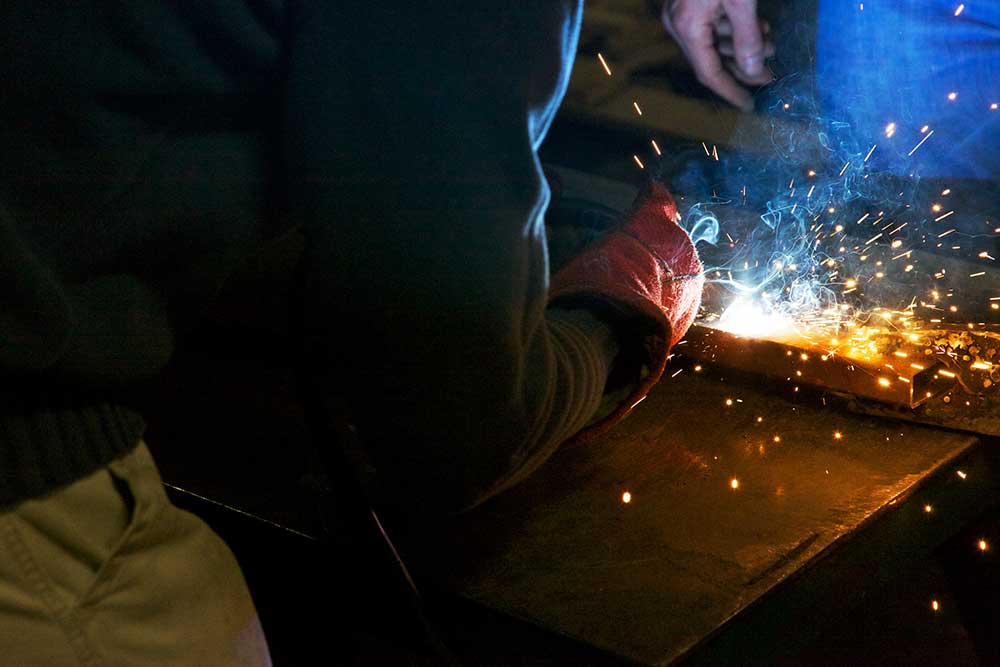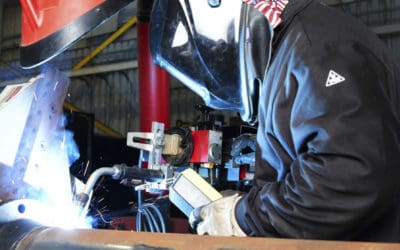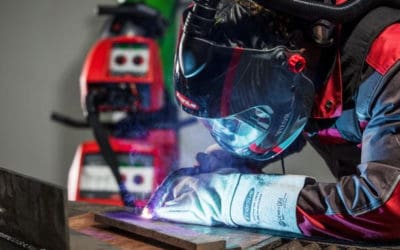The precipitation hardening (PH) stainless steels are a family of corrosion resistant alloys some of which can be heat treated to provide tensile strengths of 850MPa to 1700MPa and yield strengths of 520MPA to over 1500MPa – some three or four times that of austenitic stainless steel such as type 304 or type 316. They are used in the oil and gas, nuclear and aerospace industries where a combination of high strength, corrosion resistance and a generally low but acceptable degree of toughness is required. Precipitation hardening is achieved by the addition of copper, molybdenum, aluminium and titanium either singly or in combination.
Stainless Steel Composition
The family of precipitation hardening stainless steels can be divided into three main types – low carbon martensitic, semi-austenitic and austenitic – typical compositions of some of the steels are given in Table 1.
| Specification | Common Name | Type | Typical Chemical Analysis % | ||||||||
| C | Mn | Cr | Ni | Mo | Cu | Al | Ti | Others | |||
| A693 Tp630 | 17/4PH | martensitic | 0.05 | 0.75 | 16.5 | 4.25 | – | 4.25 | – | – | Nb 0.3 |
| FV 520 | austenitic-martensitic | 0.05 | 0.6 | 14.5 | 4.75 | 1.4 | 1.7 | – | – | Nb 0.3 | |
| A693 Tp631 | 17/7PH | austenitic-martensitic | 0.06 | 0.7 | 17.25 | 7.25 | – | – | 1.25 | – | – |
| PH 15/7 Mo | austenitic-martensitic | 0.06 | 0.7 | 15.5 | 7.25 | 2.6 | – | 1.3 | – | – | |
| A 286 | austenitic | 0.04 | 1.45 | 15.25 | 26.0 | 1.25 | – | 0.15 | 2.15 | V 0.25 B 0.007 |
|
| JBK 75 | austenitic | 0.01 | 0.04 | 14.75 | 30.5 | 1.25 | – | 0.30 | 2.15 | V 0.25 B 0.0017 |
|
| 17/10P | austenitic | 0.07 | 0.75 | 17.2 | 10.8 | P 0.28 | |||||
Table 1: Typical Compositions of some commoner precipitation hardening stainless steels
The martensitic PH steels, of which 17/4PH is the most common, transform to martensite at low temperatures, typically around 250°C, and are further strengthened by ageing at between 480 and 620°C.
Austenitic Steels
The austenitic-martensitic PH steels are essentially fully austenitic after solution treatment and require a second heat cycle to 750°C/2 hours before cooling to room temperature to form martensite. Some of these alloys need to be refrigerated (-50/-60°C for eight hours) following this heat treatment to ensure full transformation to a stable austenitic/martensitic structure although the two most commonly used alloys, FV520 and 17/7PH, do not require refrigeration to develop optimum properties.
Ageing of these alloys occurs at temperatures between 500 to 600°C. The austenitic grades are stable down to room temperature, improvements in strength being from the precipitates formed by ageing at 650 to 750°C. These fully austenitic grades can exhibit good toughness and some may be used at cryogenic temperatures.
For best weldability, it is recommended that all three types of alloys are supplied in the annealed, solution treated or overaged condition. Alloys in the form of sheet or strip may be in a cold worked condition and weldability is seriously compromised. As with many precipitation hardening alloys, achieving mechanical properties in the weld and HAZs to match those of the parent material is a problem. Even with matching welding consumables, a full solution treatment and age hardening, the maximum strength of a joint in the semi-austenitic and austenitic alloys is likely to be only some 90% of that of the base metal.
Martensitic Steels
Martensitic PH steels in the solution-treated condition can be welded with most of the conventional arc welding processes although the best toughness will be achieved with the TIG (GTAW) process as this provides the cleanest weld metal. Even better toughness can be achieved using power beam processes (electron beam or laser welding). Matching filler metals are available for most of the steels in this group enabling matching mechanical properties to be achieved by carrying out a post weld ageing heat treatment.
If a joint is very highly restrained then 17/4PH may fail along the fusion line by a form of reheat cracking during the ageing heat treatment. In these circumstances, the component should be welded in the overaged condition and then given a solution heat treatment followed by the PWHT described below. Austenitic filler metals such as 308L or, for higher weld metal strength, a duplex filler metal such as 2205, can be used where lower strength joints can be tolerated or cracking due to high restraint is a problem. PWHT is not possible if a duplex filler metal is used or recommended for austenitic weld metal due to embrittlement.
The martensite in these steels is relatively soft due to the low carbon content so preheat is not generally necessary, although for thick, (above 25mm) highly restrained joints, a preheat of around 100°C has been found to be useful in reducing the risk of cracking. Because of the low temperature at which these steels transform to martensite a maximum interpass temperature of 200°C is recommended.
Maintaining a very high interpass temperature results in the entire weld transforming to martensite on cooling to room temperature and the volume change that occurs when this happens can then lead to a form of quench cracking. The stress raising effect of the notch in the root of fillet welds and partial penetration butt welds has been found to cause cracking. Provided the reduction in strength can be tolerated, a Tp308L root pass can be used to solve this problem. It has also been found that 17/4PH castings may form HAZ hot cracks during welding; for cast items the copper content is therefore limited to 3% maximum.
PWHT generally comprises a 750°C soak and cool to room temperature to ensure that the steel is 100% martensitic followed by ageing at 550°C. This should give UTS of 900 to 1000MPa, yield strength 800 to 900MPa and ductility of some 15% depending upon the composition of the alloy and the temperature of the ageing heat treatment.
The semi-austenitic alloys are generally supplied in the solution treated condition. This means that the steel is fully austenitic and preheat is not generally required although for welding of thick and highly restrained joints a preheat of around 100°C has been found to be helpful. All the common arc welding processes may be used although, as above, TIG (GTAW) will give the best properties.

For alloys containing aluminium, eg 17/7PH, MMA and submerged arc welding should be avoided as a good proportion of the aluminium is lost during welding; inert gas shielded processes are therefore preferred. The weld pool is less fluid than the non-aluminium alloys. Matching composition filler metals for FV520 are readily available but 17/7PH consumables are difficult and expensive to obtain so parent metal sheared from a strip is often used for TIG welding. Alternatively, a 17/4PH or FV520 filler may be used; a preheat of 100°C is advisable if the 17/4PH filler is used. PWHTs are similar to those used for the martensitic steels but, without a full solution heat treatment and matching filler metal, strengths matching those of the parent metal are unlikely to be achieved.
For Best Results
It is recommended that the fully austenitic PH steels are welded in the solution treated condition; a water or oil quench from around 980°C. The ageing process is very sluggish, requiring some 15 hours at 720°C to develop full strength and this means that the HAZ is virtually unchanged from the parent metal. Optimum strength can therefore be developed during the post-weld ageing treatment. These steels, like the austenitic stainless steels, are insensitive to cold cracking and do not require to be pre-heated. They are, however, very sensitive to hot cracking due to them being fully austenitic. This makes the welding of thick sections problematic and requires the welding conditions to be very closely controlled with low heat input, small weld beads and interpass temperature controlled to less than 150°C.
Aerospace alloys such as AMS 5858, equivalent to A286, have been produced with improved weldability. The 17/10P grade is particularly sensitive and cannot be welded with matching fillers; a type 312 (29Cr/9Ni) filler gives the best chance of success, although hot cracking in the HAZ may still occur.
Due to the presence of aluminium and/or titanium in many alloys, only the inert gas shielded arc welding processes should be used. Some matching composition filler metals are available, again in aerospace grades such as AMS 5804 and these can be aged to give strengths close to those of the parent metal. Alternatively, either austenitic, duplex or nickel-based weld filler metals may be used.
As is apparent, the metallurgy of these steels can be complex and if there is any doubt concerning welding or heat treatment the advice of specialists should be sought.
Copyright © TWI Ltd 2014
The content of this article was correct at the time of publication.
This article was written by Gene Mathers.



